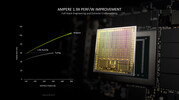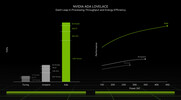NVIDIA RTX A500 Laptop GPU vs Nvidia RTX 500 Ada Generation Laptop GPU
NVIDIA RTX A500 Laptop GPU
► remove from comparison
The NVIDIA RTX A500 Laptop GPU or A500 Mobile is a professional graphics card for mobile workstations. It is based on the GA107 Ampere chip and offers a slower performance than the GeForce RTX 3050 Laptop GPU. It offers 2,048 CUDA, 16 Raytracing and 64 Tensor cores paired with a 64 Bit memory bus. It is available in different variants from 20 - 60 Watt (TGP) with different clock speeds (and performance). The GPU supports eDP 1.4b to connect the internal monitor and DisplayPort 1.4 and HDMI 2.1 for external connections.
There is no more Max-Q variant (formerly used for the low power variants) but every OEM can choose to implement Max-Q technologies (Dynamic Boost, WhisperMode).
The raw performance should be slower than the GeForce RTX 3050 for laptops at the same TGP level. Both GPUs depend heavily on good cooling and a high TGP for good performance. At a similar power consumption level the RTX A500 should be clearly faster than the old T500 and T550.
The GA107 chip offers 2.560 FP32 ALUs of which half can also execute INT32 instructions (i.e. 1,280 INT32 ALUs). With Ampere all shaders could still execute FP32 or INT32 instructions. The raytracing and tensor cores on the chip were also improved according to Nvidia. The A500 can only use 2048 CUDA cores. The Ampere chips also include an improved 5th generation video encoder (NVENC for H.264 and H.265) and a 7th generation decoder (for various formats now including AV1).
The GA107 chip is manufactured by Samsung in 8nm (8N), which is not quite able to keep up with the 7nm node at TSMC (e.g. used by AMD and also for the professional GA100 Ampere chip).
Nvidia RTX 500 Ada Generation Laptop GPU
► remove from comparison
The Nvidia RTX 500 Ada Generation, not to be confused with the A500, P500 and the T500, is a lower-end professional graphics card for use in laptops that sports 2,048 CUDA cores and a paltry 4 GB of GDDR6 VRAM. We believe this graphics card to be a heavily cut-down GeForce RTX 4050 Laptop; therefore, both should employ the Ada Lovelace AD107 chip built with TSMC's 5 nm process. The RTX 500 was launched in February 2024. The Nvidia-recommended TGP range for this graphics card is moderately wide at 35 W to 60 W [the second figure includes the Dynamic Boost, it seems] leading to noticeable performance differences between different systems powered by what is supposed to be the same graphics card.
Quadro series graphics cards ship with much different BIOS and drivers than GeForce cards and are targeted at professional users rather than gamers. Commercial product design, large-scale calculations, simulation, data mining, 24 x 7 operation, certified drivers - if any of this sounds familiar, then a Quadro card will make you happy.
Architecture and Features
Ada Lovelace brings a range of improvements over older graphics cards utilizing the outgoing Ampere architecture. It's not just a better manufacturing process and a higher number of CUDA cores that we have here; under-the-hood refinements are plentiful, including an immensely larger L2 cache, an optimized ray tracing routine (a different way to determine what is transparent and what isn't is used), and other changes. Naturally, these graphics cards can both encode and decode some of the most widely used video codecs, AVC, HEVC and AV1 included; they also support a host of proprietary Nvidia technologies, including Optimus and DLSS 3, and they can certainly be used for various AI applications.
The RTX 500 Ada features 16 RT cores of the 3rd generation, 64 Tensor cores of the 4th generation and 2,048 CUDA cores. Increase those numbers by 25%, and you get the RTX 1000 Ada - as long as we pay no attention to clock speed differences, of course. Unlike costlier Ada Generation professional laptop graphics cards, the RTX 500 comes with just 4 GB of non-ECC VRAM; the lack of error correction makes this card less suitable for super-important tasks and round-the-clock operation. The VRAM is just 64-bit wide, delivering an anemic bandwidth of ~128 GB/s.
The RTX 500 Ada Generation makes use of the PCI-Express 4 protocol, just like Ampere-based cards did. 8K SUHD monitors are supported, however, DP 1.4a video outputs may prove to be a bottleneck down the line.
Performance
At 50 W (35 W + 15 W Dynamic Boost), the graphics card can handle most 2023 and 2024 games like Baldur's Gate 3 at 1080p on high graphics settings. With a Geekbench 6.2 OpenCL GPU score of 61,500 points and a Blender v3.3 Classroom CUDA score of 71 seconds, it's clear the Ada is so much faster than any integrated GPUs on the market including the 890M.
Power consumption
With the latest Nvidia graphics cards, laptop makers are free to set the TGP according to their needs within a fairly wide range. With the RTX 500 Ada, we have the lowest value recommended sitting at just at 35 W while the highest value is 60 W [this most likely includes Dynamic Boost]. Real-world performance of the slowest RTX 500 Ada will probably be around 40% lower than that of the fastest one.
Last but not the least, the improved 5 nm process (TSMC 4N) the AD107 chip is built with makes for decent energy efficiency, as of early 2024.
| NVIDIA RTX A500 Laptop GPU | Nvidia RTX 500 Ada Generation Laptop GPU | |||||||||||||||||||||||||||||||||||||||||||||||||
| RTX Ada Generation Laptop GPU Series |
|
| ||||||||||||||||||||||||||||||||||||||||||||||||
| Codename | GA107 | |||||||||||||||||||||||||||||||||||||||||||||||||
| Architecture | Ampere | Ada Lovelace | ||||||||||||||||||||||||||||||||||||||||||||||||
| Pipelines | 2048 - unified | 2048 - unified | ||||||||||||||||||||||||||||||||||||||||||||||||
| Raytracing Cores | 16 | 16 | ||||||||||||||||||||||||||||||||||||||||||||||||
| Tensor / AI Cores | 64 | 64 | ||||||||||||||||||||||||||||||||||||||||||||||||
| Theoretical Performance | 7.3 TFLOPS FP32 | |||||||||||||||||||||||||||||||||||||||||||||||||
| Memory Speed | 14000 MHz | 12000 effective = 1500 MHz | ||||||||||||||||||||||||||||||||||||||||||||||||
| Memory Bus Width | 64 Bit | 64 Bit | ||||||||||||||||||||||||||||||||||||||||||||||||
| Memory Type | GDDR6 | GDDR6 | ||||||||||||||||||||||||||||||||||||||||||||||||
| Max. Amount of Memory | 4 GB | 4 GB | ||||||||||||||||||||||||||||||||||||||||||||||||
| Shared Memory | no | no | ||||||||||||||||||||||||||||||||||||||||||||||||
| Memory Bandwidth | 112 GB/s | 128 GB/s | ||||||||||||||||||||||||||||||||||||||||||||||||
| API | DirectX 12_2, Shader 6.7, OpenGL 4.6 | DirectX 12 Ultimate, Shader 6.7, OpenGL 4.6, OpenCL 3.0, Vulkan 1.3 | ||||||||||||||||||||||||||||||||||||||||||||||||
| Power Consumption | 60 Watt (20 - 60 Watt TGP) | 60 Watt (35 - 60 Watt TGP) | ||||||||||||||||||||||||||||||||||||||||||||||||
| technology | 8 nm | 5 nm | ||||||||||||||||||||||||||||||||||||||||||||||||
| PCIe | 4 | 4.0 x16 | ||||||||||||||||||||||||||||||||||||||||||||||||
| Date of Announcement | 30.03.2022 | 27.02.2024 | ||||||||||||||||||||||||||||||||||||||||||||||||
| Link to Manufacturer Page | nvdam.widen.net | images.nvidia.com | ||||||||||||||||||||||||||||||||||||||||||||||||
| TMUs | 64 | |||||||||||||||||||||||||||||||||||||||||||||||||
| ROPs | 32 | |||||||||||||||||||||||||||||||||||||||||||||||||
| Displays | 4 Displays (max.), HDMI 2.1, DisplayPort 1.4a | |||||||||||||||||||||||||||||||||||||||||||||||||
| Notebook Size | medium sized |
Benchmarks
3DM Vant. Perf. total + NVIDIA RTX A500 Laptop GPU
specvp12 sw-03 + NVIDIA RTX A500 Laptop GPU
Cinebench R15 OpenGL 64 Bit + NVIDIA RTX A500 Laptop GPU
GFXBench T-Rex HD Offscreen C24Z16 + NVIDIA RTX A500 Laptop GPU
Average Benchmarks NVIDIA RTX A500 Laptop GPU → 100% n=40
Average Benchmarks Nvidia RTX 500 Ada Generation Laptop GPU → 165% n=40
* Smaller numbers mean a higher performance
1 This benchmark is not used for the average calculation
Game Benchmarks
The following benchmarks stem from our benchmarks of review laptops. The performance depends on the used graphics memory, clock rate, processor, system settings, drivers, and operating systems. So the results don't have to be representative for all laptops with this GPU. For detailed information on the benchmark results, click on the fps number.

F1 24
2024
Ghost of Tsushima
2024
Alone in the Dark
2024
Dragon's Dogma 2
2024
Last Epoch
2024
Helldivers 2
2024
Enshrouded
2024
Total War Pharaoh
2023
Baldur's Gate 3
2023
F1 23
2023
Hogwarts Legacy
2023
F1 22
2022
Far Cry 6
2021
Far Cry 5
2018
X-Plane 11.11
2018
Dota 2 Reborn
2015
The Witcher 3
2015
GTA V
2015Average Gaming NVIDIA RTX A500 Laptop GPU → 100%
Average Gaming 30-70 fps → 100%
Average Gaming Nvidia RTX 500 Ada Generation Laptop GPU → 157%
Average Gaming 30-70 fps → 162%
| NVIDIA RTX A500 Laptop GPU | Nvidia RTX 500 Ada Generation Laptop GPU | |||||||||||||
|---|---|---|---|---|---|---|---|---|---|---|---|---|---|---|
| low | med. | high | ultra | QHD | 4K | low | med. | high | ultra | QHD | 4K | |||
| F1 24 | 82.4 | 71.9 | 32.9 | 11.7 | 112.9 | 80.8 | 26.5 | 16 | 22 | |||||
| Ghost of Tsushima | 34.6 | 27.5 | 19.1 | 14.1 | 56.4 | 47.1 | 40.2 | 30.9 | 22 | |||||
| Alone in the Dark | 80.1 | 68.6 | 58.6 | 43.8 | ||||||||||
| Dragon's Dogma 2 | 23.6 | 14.5 | ||||||||||||
| Last Epoch | 76.7 | 58.2 | 49.3 | 33.3 | ||||||||||
| Helldivers 2 | 19.5 | 12.8 | 12 | 10.9 | ||||||||||
| Enshrouded | 24.4 | 18.7 | 14.3 | 8.28 | ||||||||||
| Cyberpunk 2077 2.2 Phantom Liberty | 42 | 32 | 24 | 20 | 10.4 | 4.29 | 52.9 | 37.7 | 25.4 | 25 | 19.8 | |||
| Baldur's Gate 3 | 40 | 33 | 29 | 28 | 17.8 | 69.4 | 53.6 | 39 | 38.9 | 26.8 | ||||
| F1 23 | 57 | 56.3 | 43.1 | 10.9 | 6.63 | 136.5 | 119.8 | 84.1 | 25 | 16 | ||||
| Hogwarts Legacy | 23 | 19.6 | 10.6 | 5.43 | ||||||||||
| F1 22 | 92.5 | 85.2 | 57.8 | 16.9 | 150.4 | 134.4 | 99.6 | 32.9 | ||||||
| Tiny Tina's Wonderlands | 66.2 | 53.5 | 36.2 | 27.6 | ||||||||||
| Strange Brigade | 176 | 76 | 62 | 54 | 39.2 | 316 | 126 | 104 | 91 | 63 | ||||
| Far Cry 5 | 82 | 54 | 48 | 44 | 135 | 86 | 78 | 74 | 50 | |||||
| X-Plane 11.11 | 116 | 94 | 78 | 128.3 | 103.5 | 81.5 | ||||||||
| Final Fantasy XV Benchmark | 85 | 45 | 32 | 23.3 | 130.5 | 71 | 50 | 36.1 | ||||||
| Dota 2 Reborn | 159 | 131 | 104 | 98 | 176.2 | 156.1 | 148.1 | 137.4 | ||||||
| The Witcher 3 | 155 | 93 | 55 | 29 | 278 | 175 | 91 | 51 | 36 | |||||
| GTA V | 173.3 | 161.7 | 89.7 | 42.9 | 29.8 | 182.7 | 177.4 | 138.2 | 64.6 | 45.1 | ||||
| NVIDIA RTX A500 Laptop GPU | Nvidia RTX 500 Ada Generation Laptop GPU | |||||||||||||
| low | med. | high | ultra | QHD | 4K | low | med. | high | ultra | QHD | 4K | < 30 fps < 60 fps < 120 fps ≥ 120 fps | 4 4 8 4 | 4 7 6 2 | 7 9 4 | 11 5 1 | 5 1 | 1 | < 30 fps < 60 fps < 120 fps ≥ 120 fps | 2 2 9 | 3 5 5 | 2 3 6 2 | 3 4 3 1 | 5 4 1 | |
For more games that might be playable and a list of all games and graphics cards visit our Gaming List


















